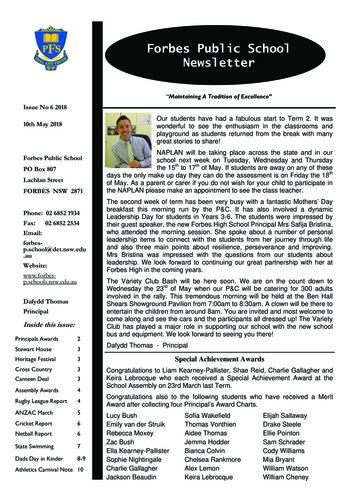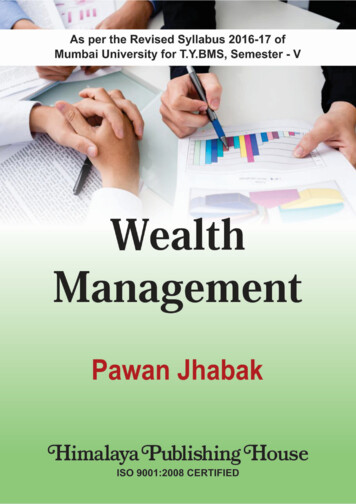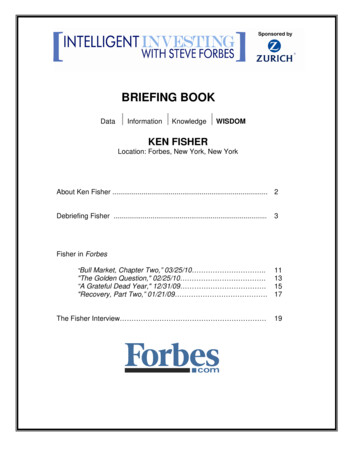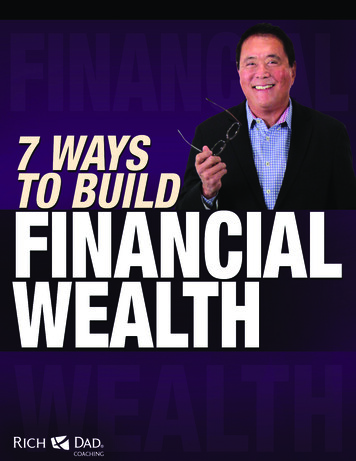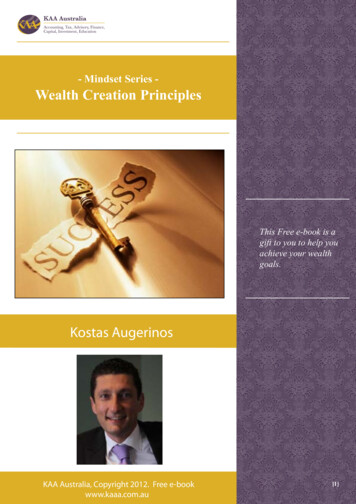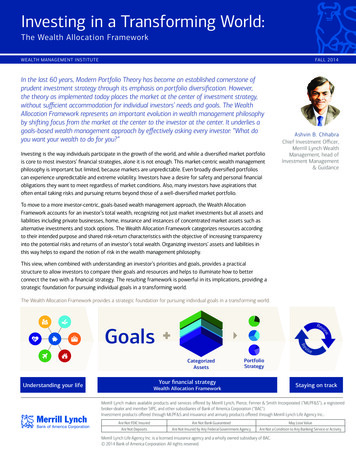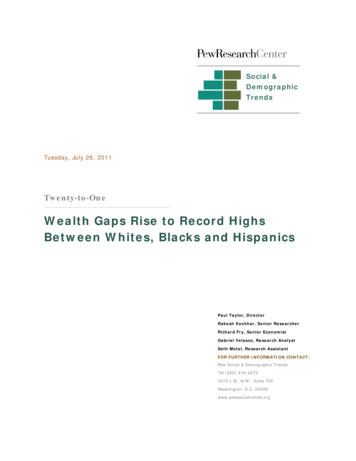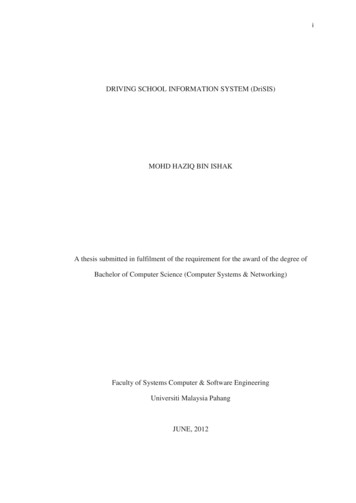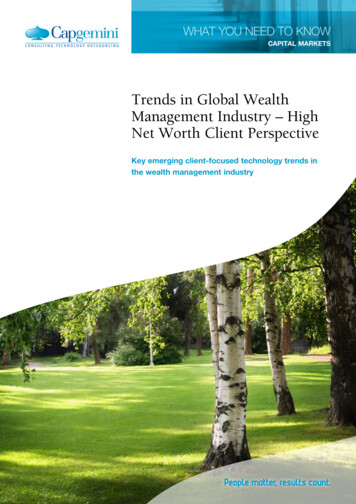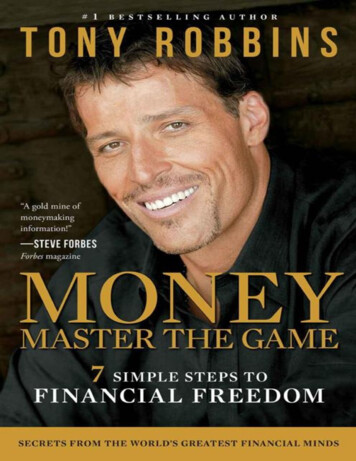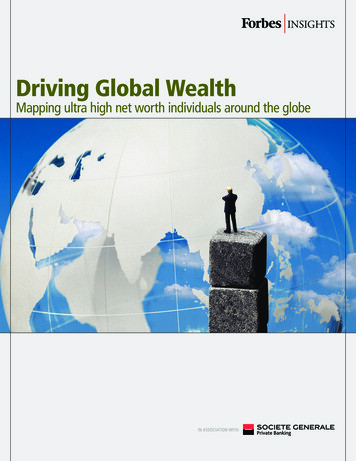
Transcription
Driving Global WealthMapping ultra high net worth individuals around the globein association with:
Table of ContentsKey findings 3Introduction: Emerging Wealth Takes Over 4The Lingering Impact of the Global Downturn 5Emerging Wealth from Emerging Markets 6Managing Family Involvement 8Creating a Philanthropic Legacy 11Finding Success in Public Service 13Global Citizens Who Stay Put 15Conclusion: Emerging Wealth, Emerging Markets, Emerging Opportunities 16Methodology 16 Copyright Forbes 2011Appendix A: Ultra High Net Worth Individuals by Country 17Appendix B: Research Definitions 292
he last few years have been historic for wealthy individuals—not so much in their importance but inhow they’ve changed some of the attitudes and characteristics of this unique investment sector. Theglobal credit crisis had an impact on all levels of society, including the very wealthy, that saw gainsthey had made disappear in the sudden market volatility. And while signs of recovery appeared during thepast year, the wealthy, as everyone else, have been taking a more guarded approach to risk.At the same time, entering the second decade of the21st century, the balance of global wealth has begun toshift from traditional western economies to the neweremerging markets. The unprecedented growth of theChinese economy, the expansion of India as a repositoryfor innovation, and the ongoing progress of markets inRussia, Brazil and other developing nations, has led tothis swing in the nature of the world’s richest individuals and families.In fact, our study suggests that the center of growth forUHNWIs has shifted eastward. While the U.S. still hasthe greatest number of UHNWIs, China, Russia and Indiahave overtaken Western Europe in the number of billionaires they produce. This marks a fundamental shift in thedemographics of the world’s ultra-rich, and this could havean impact on spending and investing in the future.Simply put, it is not just the number of wealthy individuals in these emerging markets, but how money isflowing into these areas from around the globe. As theylook for new investing opportunities, UHNWIs saw thatthese emerging markets were less affected by the 2008-09downturn than were funds and investments in the U.S. andEurope. Today, they are adding these opportunities to theirwealth management portfolios.To gain a greater understanding of the characteristicsof ultra high net worth individuals (UHNWIs), and howthis investment segment is developing, Forbes Insights,in association with Societe Generale Private Banking,conducted an in-depth analysis of the world’s wealthiest individuals. This exclusive data is derived from ForbesMagazine’s database of the world’s wealthiest people, looking at both people who made the “billionaire’s” list in2010, as well as other UHNWIs. Copyright Forbes 2011This study looks at the characteristics of UHNWIs ina dozen global markets: Brazil, China, France, Germany,Hong Kong, India, Mexico, the Middle East, Russia,Singapore, the U.K., and the U.S. Analysis was conductedon ten different criteria, including: S ource of wealth: Is the wealthy individual self-made,or did he or she inherit wealth? Company ownership: Is the individual’s companyprivate or publicly held? Family: Does the individual have children or otherrelatives involved in his or her business? Employment: Is the individual still involved in theventure, retired, or a full-time investor? Net worth: What is the range of the net worth of theindividuals being analyzed? C itizenship and residence: Does the individual holdcitizenship and residence in the same country or in different countries? Political involvement: How involved is the individualin national or local politics? Charitable foundation: Does the individual fund orrun his or her own charitable foundation, or does theindividual otherwise make philanthropy and giving alarge part of his or her life? Age: How old is the individual? Gender: Is the individual male or female?3
Key FindingsForbes Insights, in association with Societe Generale Private Banking, examined the unique characteristics of ultra high net worthindividuals (UHNWIs) in a dozen countries. The analysis is based on exclusive data from Forbes Magazine’s database of the world’swealthiest people. The minimum net worth of the individuals studied was US 1 billion, with three exceptions: India ( 500 millionminimum), China ( 425 million minimum), and Singapore ( 190 million minimum).Key findings from this analysis include: Copyright Forbes 2011 hile recovery seems to have come quickly to many UHNWIs, there are still lingering effects from the 2008-09Wglobal downturn. In particular, the impact has been on some of their investing attitudes and actions. Based on interviewsand conversations with UHNWIs, they appear to have reduced their risk exposure, but have significant concerns about thepossible impact of inflation over the coming years. In addition, many are revising their portfolios with greater investment inemerging markets such as China and the Asia Pacific region, where they believe there is less potential volatility. Finally, forsome UHNWIs, the post-downturn timeframe has been an opportunity to review their advisor relationships. he greatest area of UHNWI growth has been in the world’s emerging economies, particularly the so-called BRICTnations of Brazil, Russia, China, and India. Today, both China and Russia have more than 100 billionaires in their ranks,putting them second and third behind the U.S. But UHNWIs in these emerging markets are different from those elsewhere inthe world. They are younger; the average age of the UHNWI in Russia is just 49 and in China it is 50. They are predominantlyself-made, having been responsible for creating their own wealth. They remain involved in their businesses. But they are stilldetermining what they will do with their wealth, trailing other markets in areas such as philanthropy, for example. here are extremely strong family links among the UHNWIs studied. This is a global phenomenon present in nearly allTmarkets, with a few notable exceptions such as Russia. In many societies, keeping family close is a priority, as they have theirchildren and other family members involved in their businesses. Still, as generations pass, some conflicts can arise, particularlywhen investments are managed by a family office. hilanthropy and charity remain priorities for many UHNWIs as they look for ways to create a more lastingPlegacy and have a greater impact on society. In three quarters of the markets studied, more than 40% of the UHNWIsfund their own charitable foundation, or run a charitable foundation founded or started by other family members. Yet this isnot yet universal. China remains a significant outlier, as only 7% of UHNWIs have foundations. But efforts are underway toencourage greater giving and philanthropy from the emerging Chinese billionaires. aving made their marks in the business world, some UHNWIs see their next steps as shaping policy and debateHin the public sector. Tracking the political activity of the world’s richest people is difficult. In some nations such as the U.S.or India, many UHNWIs individuals are open in their support of certain political causes, and some billionaires have turnedfrom business to politics. But elsewhere in the world (such as in Europe), UHNW individuals have been less open in theirpolitical involvement, either not being involved or keeping their positions unknown. espite being global citizens, many UHNWI maintain citizenship and residence in the same country. The figure isDover 90% for most markets studied. The biggest outlier is Hong Kong—still maintaining its image as a haven for globalwealth—where 28% of the UHNW individuals studied hold citizenship and residence in different countries.4
The Lingering Impact of the Global DownturnNobody was untouched by the global recession of 200809, and the effect of the downturn lingered into 2010 forsome UHNWIs. Still, the overall impact wasn’t just relatedto the value of portfolios. Certainly those were affected,but, for many UNHWIs, the biggest shift may have beenrelated to their investing attitudes and actions.Based on conversations and interviews with UHNWIsacross the globe, as well as with some of their advisors,many of the world’s wealthiest were stung by the downturn, but not to the same extent as other investors. (Mostof these interviews were conducted on the condition thatthey would be used for background and that informationnot be attributable to the individual.) In the words ofa U.S.-based technology investor: “The thing to consider is that in this downturn, it wasn’t just a few assets,it was nearly all asset classes. So everyone got burnednearly equally.”Still, the recession has influenced how some of theseUHNWIs are investing today, and how they interact withtheir advisors, as the anecdotes below describe:A speedy recoveryMany of the UHNWIs interviewed indicated they felt theirinvestments had recovered more quickly after the downturn than perhaps the “general public” had. In some cases,they felt their advisors had helped them move away fromthe more volatile real estate and public markets prior to thedepth of the downturn, and encouraged them to returnto some of those investments at the right time. “I’ve donewell,” said one U.S.-based investor in charge of his family’soffice. “I feel we saw what was coming and moved away atthe right time.”Lowering risk, but fearing inflationUNHWIs, almost as a rule, are often more moderate risk takers, focused more on wealth preservation and strategic growthrather than high-return/high-risk investment. Following therecession, some of those interviewed who had dabbled withhigher-risk investments such as hedge funds were retreatingfrom those in favor of more mainstream equities.The biggest concern many of the UHNWIs is inflation. Copyright Forbes 2011“Our advisors have been warning us about the risk ofinflation,” said a second-generation Europe-based manufacturer. “It makes sense to prepare for it.” While he wouldnot disclose his specific investing plan, he did allude tomoving away from the dollar.Looking at developing nationsAs they assess their investment portfolios, some of theUHNWIs interviewed are examining putting a greatershare of their capital into emerging markets, particularly inthe Asia Pacific area. While investments in emerging markets also fell during the economic downturn, they were notas volatile as those in developed markets, and they recovered more quickly, said one interviewee.Noted a U.K.-based investment advisor for UHNWIs,“The emerging markets as a whole are growing at a 7 percent clip. The developed countries have enormous debtwhereas the emerging nations have healthy balance sheets.”The advisor added that he has recommended buildingportfolios that “decouple the emerging world with thedeveloped world. I believe that’s going to play a role innearly all strategic wealth management.”Turnover in investor relationshipsIt’s hard to say whether it is attributable to the post-downturn hangover or simply a matter of it being an opportunityto shake things up, but a number of UHNWIs indicatedthey were assessing new advisor relationships, or looking torestructure their existing investment advisor roster.For one UHNWI who made his money in the U.S.retail industry, its nothing more than a matter of regulardue diligence. “I’m not looking to have different brokerage advisors compete against each other, but I want tobe sure that the people I work with are the best at executing my investment strategy.” As he has rebalanced hisassets to achieve his goals, he’s also replaced a couple ofhis advisors because their areas of expertise no longer fitthe portfolio’s approach.Or as another UHNWI indicated, “There’s been somechurn in relationships because sometimes, it’s just time fora change.”5
Emerging Wealth from Emerging MarketsEmerging market UHNWIs are generally youngerThe average age of the UHNW individual in Russia is 49and is 50 in China. (Fig. 1) Compare that to more established economies such as the U.S., where the average ageof a UHNWI is 66, or France, where it is 74. In otherwords, emerging market UHNWIs are often just establishing themselves, so their overall influence and activitywill likely continue for an additional decade or two. Theirwealthy status has just begun, and the long-term impact islikely to be sizable.Few economic developments have compared to the meteoric growth of China both as a global industrial powerhouse,and as a creator of unprecedented wealth for those entrepreneurs, industrialists, and investors who have succeededover the past decade. While other economies contractedduring the global credit crisis, China remained strong andvibrant, and today it leads the so-called BRIC nations—Brazil, Russia, India and China—as the greatest areas ofgrowth for UHNWIs.Consider some recent numbers: In the 2011 Forbes billionaire’s list, the BRIC nations produced more than halfof the new billionaires to join the ranking. Until the past12 months, no nation other than the U.S. was home tomore than 100 billionaires—today China has 115 andRussia 101.The analysis shows that UHNWIs in these emergingmarkets—while they have much in common with theircounterparts elsewhere in the world—also have a numberof unique characteristics.Emerging market UHNWIs are self-madeEntrepreneurship is alive and well in the BRIC nations,and is paying off handsomely for those that have succeeded.100% of the UHNWIs studied in Russia are self-made—meaning every single one was responsible for creating theirown wealth and did not inherit it.Figure 1: Average age of UHNWIs, by country7468The ultra-rich in emerging markets aremaking their fortunes at a younger age thanUHNWIs in the West. China’s and Russia’swealthy are, on average, 15 years youngerthan their counterparts in the U.S., U.K.or Germany.France Copyright Forbes ico Singapore MiddleEast60India5049ChinaRussia6
For UHNWIs in emergingmarkets, determining howto give money awaymay be more difficultthan earning it.While Russia may be an extreme in that area—especially given its political history over the past 90 years—otherwealthy individuals in the BRIC nations have been similarly entrepreneurial. In China, two thirds (66%) of theUHNWIs studied were self-made. For India, that figure is65%, and for Brazil it is 67%. The impact of this entrepreneurialism is further evident in the ongoing involvement ofthese individuals in their businesses (see below), and what islikely to be a continued expansion of their wealth based ontheir desire for ongoing success.BRIC UHNWIs are involved in their businessWhereas UHNWIs and entrepreneurs in some westernmarkets appear eager to sell their companies once theyare successful, most of those in the BRIC nations remainactively involved with their businesses. This may bebecause they are younger and not yet ready to take a morepassive role. Or it may be attributable to the high growthtrajectories for many of these companies, and the desire ofthe leaders to see that growth through.Among the UHNWIs studied, 93% of Russian UHNWindividuals, and 85% of Chinese UHNWIs are employedfull time, meaning they are in control of, directing, or running their companies. The figures for India and Brazil are78% and 75%, respectively.Emerging market UHNWIs are still determininghow to give backPhilanthropy is a mixed bag among UHNWIs in emerging markets. For many, determining how or when to givemoney away has been more difficult than earning it. As thisnew generation of titans emerges, it is unclear whether theywill be as committed to giving back their wealth as someof their western counterparts have been. For instance, just7% of Chinese UHNWIs analyzed in the study have theirown charitable foundations, a far cry from the 55% that doso in the U.S.It may be premature to say that these individuals willnot be philanthropic, however, as many may see themselvesas being at the stage of “building” their wealth. There arealso social and political issues that are unique to these markets that are affecting giving strategies—for example, isphilanthropy seen as a way to help a nation’s people, or isthat a role for the government?Ultimately, how a select number of UHNWIs inemerging markets approach philanthropy may end up guiding others. These nations have yet to have their Carnegiesor Rockefellers to usher in their ages of philanthropy.Still a Man’s WorldGender diversity has not yet come to the world of ultra-high net worth.In most of the markets studied, UHNW individuals are predominantly male. Of the markets studied, the ones withthe highest percentage of female UHNW individuals were Hong Kong (23%) and Germany (17%).In most other markets, more than 90% of UHNW were male. Copyright Forbes 20117
Managing Family InvolvementThere are extremely strong family links among theUHNWIs studied. This is a global phenomenon, and it ispresent in nearly all markets, with a few notable exceptionssuch as Russia.Clearly, in certain societies, keeping family close isa priority, and UHNWIs in these countries are morelikely to have children or other family members working in the business. (Fig. 2) More than half of UHNWIsfrom the Middle East have their children involved intheir businesses, and a similar percent have other family members involved (note that a person can have bothchildren and other family members employed). Similarly,in India, 58% of UHNWIs have their children workingwith them.Within many of these developing nations, one person’swealth is often seen as something to be shared—a legacythat can enrich both the immediate and the extended family. “In our culture, family still comes first. Wealth becomesa way to bring everyone closer together,” said a wealthyfinance executive from Latin America. “It is important toshare our advantages with those closest to us.”But involving family in wealth strategies certainlycomes with its challenges. Once a family has significantwealth, the problem becomes how to preserve it for futuregenerations. This is often a surprisingly difficult task,as it may require the family to tackle personal issues asmuch as they need to deal with investment and financialuncertainties.Figure 2: Family in ng Kong5530India5837Mexico1156Middle East5353Russia817Singapore2545U.K.UHNWIs in India, Hong Kong, the Middle East, andFrance are most likely to have children involved in theirbusiness, while those in Mexico, the Middle East, andSingapore involve other family.1114U.S.21280% Children in Business Copyright Forbes 201150%100% Other Family in Business8
To manage such conflicts, many UHNWIs turn to asingle-family office (SFO), a professional organization dedicated specifically to managing their personal fortunes.While SFO involvement was not directly analyzed in theForbes wealth list data, other studies have looked at theissues and characteristics of the SFO. According to a 2009study from the Wharton Global Family Alliance, SFOsand the families behind them are generally entrepreneurial, insofar as the families involved are often still majorityshareholders involved (similar in profile to the UHNWIsfrom the Forbes list). These families tend to view theirSFOs as private investment services, more focused on maintaining and growing wealth than on “softer” services—ahedge fund expert shouldn’t be distracted by having to dealwith domestic staff issues.“In our culture, family stillcomes first It is importantto share our advantageswith those closest to us.”Issues in the Family OfficeFor a second-generation European business owner, managing multigenerational wealth through a single-family office is attimes both a godsend and a curse. It both eases some of the issues related to investing and growth of the family fortune,but it also sets up a number of conflicts as different segments of the family have different opinions regarding allocation andrisk profiles.“Our goal for the past several decades and going forward has been to manage our wealth independently so that the principalshave enough time to devote to the business,” said the executive. “Staffing our office with professionals that don’t have a directlink to the family has been beneficial.” He added that the group has a staff of 9, including tax advisors and legal counsel.Still, he has found that as a third generation has become more involved in the SFO’s business and now sits on its committees,it is becoming increasingly necessary to outsource some of its functions. For example, the group recently decided to restaffits investing team to focus its expertise primarily on private equity placements (they used a unique performance bonus structureto lure a high-performer into the organization). Other portfolio matters are being contracted with several independentinvestment professionals.“We try to have a long-term investing vision and adhere to investing best practices,” he added. This helped the family rideout the 2009 downturn, and will help them find value in their future investments. Copyright Forbes 20119
Globally, many expect the biggest growth in familyoffices to occur in Asia, as UHNWIs in that region whohave gained their wealth over the past two decades lookto come up with ways to pass it on to the next generation.“We’ve been pretty unsophisticated investors compared toAmericans and Europeans,” said a Singapore-based investor specializing in biotech. “Wealthy Asians need to lookfor ways to grow their assets and preserve them for futuregenerations.”The importance of usingEntrepreneurial activity still drivesservices such as an SFOmost wealth creation in bothor private bank is furtheremerging and established marketsdemonstrated by underas most UHNWIs fall into thecategory of “self-made” wealth.standing the source of theUHNWI’s wealth.Entrepreneurial activity still drives the vast majorityof wealth creation in most markets—the defining characteristic of the “self-made” individual. In half the marketsstudied—Brazil, China, India, Russia, the U.K., and theU.S.—more than 60% of the UHNWIs were “self-made,”meaning that they “earned” their wealth through the success and growth of their business ventures.But even in those markets where the majority ofUHNWIs received their wealth through inheritance,many are actively involved in growing that financial legacy. (Fig. 3) For example, in France, two thirds of theUHNWIs inherited their wealth, but half are activelyinvolved today in growing the fortunes. Similarly, in theMiddle East, 42% of UHNWIs inherited their fortunes,but are still looking to grow them. Copyright Forbes 2011Figure 3: Source of 3232Hong Kong4851928India651718Mexico563311Middle 681813 Self Made Inherited Inherited and Growing Other10
Creating a Philanthropic LegacyIn 2010, many UHNWIs were issued a challenge: increasetheir charitable giving and develop a way to return theirwealth to charitable causes.The “Giving Pledge”—kicked off by Warren Buffet andBill and Melinda Gates—is an effort to have the wealthiest individuals and families in America commit to givingthe majority of their wealth to the philanthropic causes andcharitable organizations of their choice either during theirlifetime or after their death. The goal: have those who havebeen most fortunate make a moral commitment to give,and through their generosity make the world a better place.More than 50 of the wealthiest U.S. individuals andfamilies have taken the pledge. And the challenge has beenextended overseas, as Buffet and Gates traveled to China toshare their experiences with philanthropy with the wealthyentrepreneurs from that emerging nation.Philanthropy and charity have long been part and parcel with ultra high net worth, as individuals look for waysto create a more lasting legacy and have a greater impacton society.The analysis of the Forbes data suggests that this is stilltrue. In three quarters of the markets studied, more than40% of the UHNWIs fund their own charitable foundation, or run a charitable foundation founded or started byother family members. (Fig. 4) And in seven of the markets,more than 40% of the UHNWIs gave other substantialcharitable contributions; that is, made donations outside oftheir foundations, or made sizable donations without having their own or a family foundation.While many think of philanthropy as an Americannotion—people in the U.S. give more to charity thanFigure 4: Charitable ong Kong4330India4824Mexico4456Middle East6358Russia2652Singapore4313U.K.In most markets studied, foundations and charitablegiving is part of the legacy UHNWIs are trying tocreate, but the ultra-rich in emerging markets havesome catching up to do.5749U.S.55500%50%100% Charitable Foundation Other substantial charitable giving Copyright Forbes 201111
people in any other country—clearly giving has becomeglobal in nature. In the U.S., 55% of UHNW individuals studied operate charitable foundations, and of those thatdo not, nearly three quarters recorded substantial charitabledonations. Yet even more UHNWIs operate foundations inthe U.K. (57%) and France (58%). And in the Middle East,where Sharia law often directs charitable contributions,63% of UHNWIs fund a charitable foundation.Even in the emerging market of India, 48% of UHNWIshave a charitable foundation. Consider, for example, Wiprofounder Azim Premji, who has pledged much of the fortunehe made through his information technology company tohis foundation, which currently is focused on improvingpublic education in India.As noted earlier, China remains an outlier in the areaof philanthropy, as just 7% of Chinese UHNWIs havea foundation, and 35% make some sort of other substantial charitable giving. There remains great culturalhesitancy in that country to making a charitable pledge.For instance, Confucian values call for people to take careof their families first, which is often considered a reasonwhy Chinese UHNWIs leave wealth for their descendents. In fact, when Buffet and Gates visited, they hadto issue an official letter to the state news agency to clarify that attendees at their event would not be asked todonate anything.But that could be changing. After the visit by Buffet andGates, several Chinese entrepreneurs changed direction.Chen Guangbio, a recycling entrepreneur with a fortuneestimated at more than 400 million, announced on hiscompany’s website that he planned to give all his moneyaway. Others could follow his lead.Philanthropy Keeps a Legacy AliveOne could argue that the most valuable and enduring assets of a multigenerational family are its shared values, its reputation,and its place in society. Evidence of its good work can serve as a magnet to draw individual family members together andprovide direction for the future.Nowhere is this truer than in the family charitable foundation of the descendents of an American industrialist who made hisfortune more than 60 years ago. Based in a midsize city, the foundation—actually an amalgam of several foundations run bydifferent branches of the family—has two key points of focus: maintain and grow its endowment, and support the kinds ofcauses the family’s patriarch would have supported during his lifetime, according to a family board member.Maintaining and growing the endowment, the board member said, comes via the family’s commitment to supporting theirfoundations. The commercial side of the family fortune has shifted from manufacturing to investing, including commercial realestate and private equity investment. While those investments are not part of the foundation’s endowment, their ongoingsuccess provides the funds, the board member added. In terms of causes, the foundation’s charter calls for it to support areasof social equality, cultural enrichment, and local causes, including medical research and education.“It is important for us to maintain what our family stands for,” the board member said. “Our wealth came via inheritance,but our true legacy is really about what we continue to do with it.” Copyright Forbes 201112
Finding Success in Public ServicePhilanthropy is one way UHNWIs can give back tosociety. Another way is through activity in the public sector.A growing number of entrepreneurial UHNWIs,having made their fortunes in business, have turnedto politics to take their success in the private sectorand bring it to public service. Consider the number ofhigh-profile billionaires that have turned from businessto politics. New York City mayor Michael Bloombergmade his fortune via his namesake information servicesand media company. Lebanese prime minister designateNajib Mikati co-founded the telecommunications company Investcom.In most cases, these are not individuals who are looking to further enrich themselves via the public sector, orsee political involvement as a way to improve the standingof their businesses. Rather, many see it as a way to shapethe debate on critical issues, and use their business experience for public service.Still, tracking the political activity of the world’srichest people is difficult. The Forbes Insights researchdefines “political involvement” as those individuals whohave donated money to a political party in a manner thatis recorded in public record; have been known to attendpolitical fundraisers; have served on or in a governmentcabinet, task force, or partnership on the local, federal orinternational level; have attended global economic conferences sponsored by governing bodies; or have run for orserved in elected office. Copyright Forbes 2011Many UHNWIs see politicalinvolvement as a way toshape public debate and usetheir business experiencefor public service.13
While this definition can identify some of the political involveme
ing at both people who made the "billionaire's" list in . self-made, having been responsible for creating their own wealth. . and the effect of the downturn lingered into 2010 for
